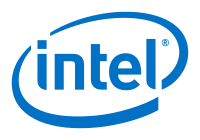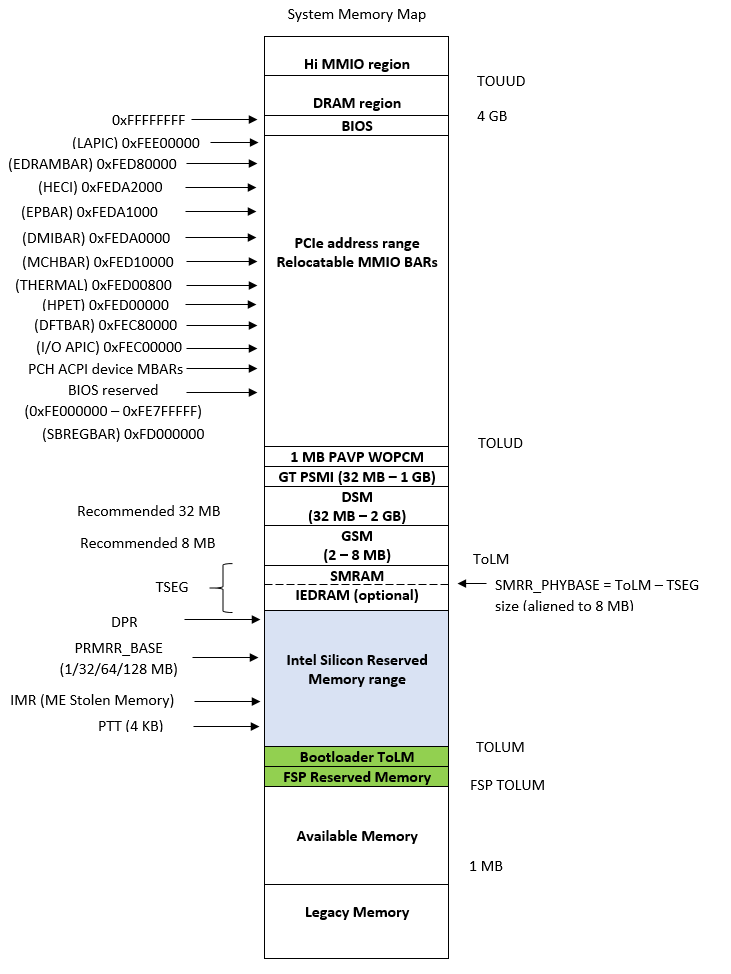 |
CoffeeLake Intel(R) Firmware Support Package (FSP) Integration Guide
|
3 FSP Integration
3.1 Assumptions Used in this Document
The FSP for the CoffeeLake platform is built with a preferred base address given by PcdFspAreaBaseAddress and so the reference code provided in the document assumes that the FSP is placed at this base address during the final boot loader build. Users may rebase the FSP binary at a different location with Intel's Binary Configuration Tool (BCT) before integrating to the boot loader.
For other assumptions and conventions, please refer section 8 in the FSP External Architecture Specification version 2.0.
3.2 Boot Flow
Please refer Chapter 7 in the FSP External Architecture Specification version 2.0 for Boot flow chart.
3.3 FSP INFO Header
The FSP has an Information Header that provides critical information that is required by the bootloader to successfully interface with the FSP. The structure of the FSP Information Header is documented in the FSP External Architecture Specification version 2.0 with a HeaderRevision of 3.
3.4 FSP Image ID and Revision
FSP information header contains an Image ID field and an Image Revision field that provide the identification and revision information of the FSP binary. It is important to verify these fields while integrating the FSP as API parameters could change over different FSP IDs and revisions. All the FSP FV segments(FSP-T, FSP-M and FSP-S) must have same FSP Image ID and revision number, using FV segments with different revision numbers in a single FSP image is not valid. The FSP API parameters documented in this integration guide are applicable for the Image ID and Revision specified as below.
The FSP ImageId string in the FSP information header is given by PcdFspImageIdString and the ImageRevision field is given by SiliconInitVersionMajor|Minor|FspVersionRevision|FspVersionBuild (Ex:0x07020110).
3.5 FSP Global Data
FSP uses some amount of TempRam area to store FSP global data which contains some critical data like pointers to FSP information headers and UPD configuration regions, FSP/Bootloader stack pointers required for stack switching etc. HPET Timer register(2) PcdGlobalDataPointerAddress is reserved to store address of this global data, and hence boot loader should not use this register for any other purpose. If TempRAM initialization is done by boot loader, then HPET has to be initialized to the base so that access to the register will work fine.
3.6 FSP APIs
This release of the CoffeeLake FSP supports the all APIs required by the FSP External Architecture Specification version 2.0. The FSP information header contains the address offset for these APIs. Register usage is described in the FSP External Architecture Specification version 2.0. Any usage not described by the specification is described in the individual sections below.
The below sections will highlight any changes that are specific to this FSP release.
3.6.1 TempRamInit API
Please refer Chapter 8.5 in the FSP External Architecture Specification version 2.0 for complete details including the prototype, parameters and return value details for this API.
TempRamInit does basic early initialization primarily setting up temporary RAM using cache. It returns ECX pointing to beginning of temporary memory and EDX pointing to end of temporary memory + 1. The total temporary ram currently available is given by PcdTemporaryRamSize starting from the base address of PcdTemporaryRamBase. Out of total temporary memory avaiable, last PcdFspReservedBufferSize bytes of space reserved by FSP for TempRamInit if temporary RAM initialization is done by FSP and remaining space from TemporaryRamBase(ECX) to TemporaryRamBase+TemporaryRamSize-FspReservedBufferSize (EDX) is avaiable for both bootloader and FSP binary.
TempRamInit** also sets up the code caching of the region passed CodeCacheBase and CodeCacheLength, which are input parameters to TempRamInitApi. if 0 is passed in for CodeCacheBase, the base used will be 4 GB - 1 - length to be code cached instead of starting from CodeCacheBase.
- Note
- : when programming MTRR CodeCacheLength will be reduced, if SKU LLC size is smaller than the requested.
It is a requirement for Firmware to have Firmware Interface Table (FIT), which contains pointers to each microcode update. The microcode update is loaded for all logical processors before reset vector. If more than microcode update for the CPU is present, the microcode update with the latest revision is loaded.
FSPT_UPD.MicrocodeRegionBase** and FSPT_UPD.MicrocodeRegionLength are input parameters to TempRamInit API. If these values are 0, FSP will not attempt to update microcode. If a region is passed, then if a newer microcode update revision is in the region, it will be loaded by the FSP.
MTRRs are programmed to the default values to have the following memory map:
| Memory range | Cache Attribute |
|---|---|
| 0xFEF00000 - 0x00040000 | Write back |
| CodeCacheBase - CodeCacheLength | Write protect |
3.6.2 FspMemoryInit API
Please refer to Chapter 8.6 in the FSP external Architecture Specification version 2.0 for the prototype, parameters and return value details for this API.
The FspmUpdPtr is pointer to FSPM_UPD structure which is described in header file FspmUpd.h.
Boot Loader must pass valid CAR region for FSP stack use through FSPM_UPD.FspmArchUpd.StackBase and FSPM_UPD.FspmArchUpd.StackSize UPDs.
The minimum FSP stack size required for this revision of FSP is 160KB, stack base is 0xFEF17F00 by default.
The base address of HECI device (Bus 0, Device 22, Function 0) is required to be initialized prior to perform FspMemoryInit flow. The default address is programmed to 0xFED1A000.
Calculate memory map determining memory regions TSEG, IED, GTT, BDSM, ME stolen, Uncore PMRR, IOT, MOT, DPR, REMAP, TOLUD, TOUUD. Programming will be done at a different time.
3.6.3 TempRamExit API
Please refer to Chapter 8.7 in the FSP external Architecture Specification version 2.0 for the prototype, parameters and return value details for this API.
If Boot Loader initializes the Temporary RAM (CAR) and skip calling TempRamInit API, it is expected that bootloader must skip calling this API and bootloader will tear down the temporary memory area setup in the cache and bring the cache to normal mode of operation.
This revision of FSP doesn't have any fields/structure to pass as parameter for this API. Pass Null for TempRamExitParamPtr.
At the end of TempRamExit the original code and data caching are disabled. FSP will reconfigure all MTRRs as described in the table below for performance optimization.
| Memory range | Cache Attribute |
|---|---|
| 0x00000000 - 0x0009FFFF | Write back |
| 0x000C0000 - Top of Low Memory | Write back |
| 0xFF000000 - 0xFFFFFFFF (Flash region) | Write protect |
- Todo:
- program 0x1000000000 - Top of High Memory | Write back
If the boot loader wish to reconfigure the MTRRs differently, it can be overridden immediately after this API call.
3.6.4 FspSiliconInit API
Please refer to Chapter 8.8 in the FSP external Architecture Specification version 2.0 for the prototype, parameters and return value details for this API.
The FspsUpdPtr is pointer to FSPS_UPD structure which is described in header file FspsUpd.h.
It is expected that boot loader will program MTRRs for SBSP as needed after TempRamExit but before entering FspSiliconInit. If MTRRs are not programmed properly, the boot performance might be impacted.
The region of 0x5_8000 - 0x5_8FFF is used by FspSilicionInit for starting APs. If this data is important to bootloader, then bootloader needs to preserve it before calling FspSilicionInit.
It is a requirement for bootloader to have Firmware Interface Table (FIT), which contains pointers to each microcode. The microcode is loaded for all cores before reset vector. If more than one microcode update for the CPU is present, the latest revision is loaded.
MicrocodeRegionBase and MicrocodeRegionLength are both input parameters to TempRamInit and UPD for SiliconInit API. UPD has priority and will be searched for a later revision than TempRamInit. If MicrocodeRegionBase and MicrocodeRegionLength values are 0, FSP will not attempt to update the microcode. If a microcode region is passed, and if a later revision of microcode is present in this region, FSP will load it.
FSP initializes PCH audio including selecting HD Audio verb table and initializes Codec.
PCH required initialization is done for the following HECI, USB, HSIO, Integrated Sensor Hub, Camera, PCI Express, Vt-d.
FSP initializes CPU features: XD, VMX, AES, IED, HDC, x(2)Apic, Intel® Processor Trace, Three strike counter, Machine check, Cache pre-fetchers, Core PMRR, Power management.
Initializes HECI, DMI, Internal Graphics. Publish EFI_PEI_GRAPHICS_INFO_HOB during normal boot but this HOB will not be published during S3 resume as FSP will not launch the PEI Graphics PEIM during S3 resume.
Programs SA Bars: MchBar, DmiBar, EpBar, GdxcBar, EDRAM (if supported). Please refer to section 2.8 (MemoryMap) for the corresponding Bar values. GttMmadr (0xDF000000) and GmAdr(0xC0000000) are temporarily programmed and cleared after use in FSP.
3.6.5 NotifyPhase API
Please refer Chapter 8.9 in the FSP External Architecture Specification version 2.0 for the prototype, parameters and return value details for this API.
3.6.5.1 PostPciEnumeration Notification
This phase EnumInitPhaseAfterPciEnumeration is to be called after PCI enumeration but before execution of third party code such as option ROMs. Currently, nothing is done in this phase, but in the future updates, programming may be done in this phase.
3.6.5.2 ReadyToBoot Notification
This phase EnumInitPhaseReadyToBoot is to be called before giving control to boot. It includes some final initialization steps recommended by the BWG, including power management settings, Send ME Message EOP (End of Post).
3.6.5.3 EndOfFirmware Notification
This phase EnumInitEndOfFirmware is to be called before the firmware/preboot environment transfers management of all system resources to the OS or next level execution environment. It includes final locking of chipset registers
3.7 Memory Map
Below diagram represents the memory map allocated by FSP including the FSP specific regions.

/**
Generated on Wed Aug 22 2018 17:48:55 for CoffeeLake Intel(R) Firmware Support Package (FSP) Integration Guide by
 1.8.10
1.8.10